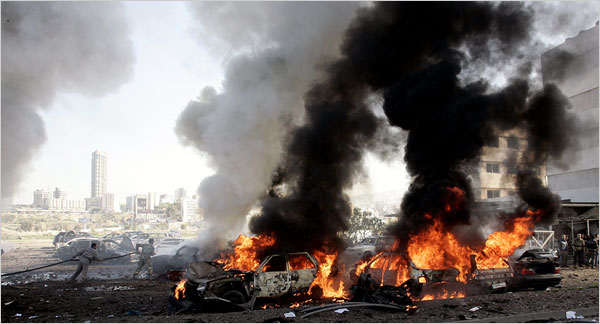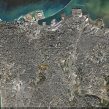A Mujahideen Bleed-Through From Iraq? Part Two – A Look at Lebanon
Publication: Terrorism Focus Volume: 5 Issue: 38

Lebanon always has been a country whose people are more loyal to family, clan, tribe, and faith than to the concept of Lebanon as a united nation-state. Since 2003, this existing internal divisiveness has been sharpened by the U.S.-led invasion and occupation of Iraq and the U.S.-led international effort to drive Syria out of Lebanon. The former opened a role for Lebanon as part of the path for would-be jihadis traveling to fight in Iraq. The latter – together with the 2006 Hezbollah-Israel war – forced the precipitate decline of effective governmental authority in Lebanon, allowing jihadis to use the country for transit and basing. This made it a target for aggressive expansionist efforts by Saudis and other Salafis and encouraged the rapid growth of internal violence between political and religious factions. Overall, the Iraq war and Syria’s departure from Lebanon gave al-Qaeda and its Islamist allies an unprecedented opportunity to infiltrate their influence and manpower into Lebanon, as well as help strengthen the Sunni Salafist trend in northern Lebanon.
It is now old-hat to say that the U.S.-led invasion of Iraq was a casus belli for Sunni Muslims worldwide, and especially among the Salafists who are prominent in al-Qaeda, other Islamist radical groups, and the Saudi regime, who are now effectively expanding their power across the Arab and Muslim worlds. A glance at the map showed jihad-bound Sunnis that Lebanon was a geographic key to infiltrating Islamist fighters into Iraq. The war itself made many Sunni Lebanese eager to assist that entry process, with some ready to go and fight there themselves.
With Syria effectively in charge of Lebanon at the start of the Iraq war, it appears that the transit of would-be mujahedeen through Lebanon was kept moving by Syrian authorities and did not initially result in the build-up of non-Lebanese Sunni Islamists within the country. The West’s pyrrhic 2005 victory in forcing President Bashar al-Assad to evacuate Syrian forces from the country, however, seems to have created a situation which now finds growing numbers of non-Lebanese Salafi Islamists present in Lebanon and a growing Salafist movement in the north – especially in Tripoli, which is Lebanon’s largest, most conservative Sunni city – as well as in the city of Sidon and Lebanon’s Palestinian refugee camps (Al-Ghad [Jordan], October 11).
In addition to the growth of Salifism and Islamist militancy engendered by the passions aroused by the Iraq war, Saudi Arabia has been fishing in troubled waters by encouraging the growth of each in northern Lebanon. Riyadh has paid for the construction of new mosques in Tripoli and reportedly has assisted militants residing in the northern territory abutting Syria (The Economist, October 2; New York Times, October 16). According to the media, Lebanese and Syrian sources are reporting that Saudi National Security Chief Prince Bandar Bin Sultan is supervising the Saudis’ pro-Salafist agenda in Lebanon, a program which includes sponsoring Islamist terrorist operations in Syria (Al-Akhbar [Beirut], September 30). Riyadh’s activities in northern Lebanon hold the promise of fulfilling two longstanding Saudi goals: (1) creating a viable, well-armed, and militant Sunni Salafi movement in Lebanon as a military counterweight to the Shia Hezbollah, and (2) to enable Riyadh to cause domestic instability for their Syrian enemy (Middle East Times, June 30).
The turmoil of post-Syrian Lebanon also has been exploited by al-Qaeda forces based in Iraq. Multiple media reports indicate that al-Qaeda fighters – mostly Yemenis, Saudis, Jordanians who left Iraq to avoid the U.S. surge and its surrogate Sunni fighters – went to both Syria and Lebanon (Naharnet, September 12). They have established themselves in Lebanon along the Syrian border, in Tripoli and in the Ain al-Hawah Palestinian refugee camp; they also have built working relationships with the Sunni militant groups Asbat al-Ansar and Fatah-al-Islam group. In 2007, the latter fought the Lebanese army for fifteen weeks at the Nahr al-Bared refugee camp (Naharnet, June 16).
In the face of growing Salafist and al-Qaeda influence, one Lebanese academic claimed, “Security in Iraq is improving, but the militants are being driven across the border. There are a large number of militants coming into Lebanon and Syria, and our countries are paying the price for what is happening in Iraq” (BBC, September 29). The academic’s words are an apt description of the westward-bound jihad highway for Sunni mujahideen that the United States and its allies have unwittingly built across Iraq.
As in Syria, the growing al-Qaeda and Saudi-backed Salifist movement in Lebanon’s north and its Palestinian refugee camps clearly is in part a product of the militant bleed-through from Iraq. But, as in Syria, Salafism’s Lebanese growth is occurring in already fertile soil: Lebanon’s Sunni north has been slowly radicalizing for much of this decade – Tripoli’s Sunni leaders long viewed Hezbollah as the “Resistance,” but now regard it as the “party of evil” – and the eviction of Syrian forces has substantially reduced Beirut’s ability to limit the growth of Salafism (Middle East Times, June 30). Bin Laden’s operatives and Saudi intelligence will continue to push these trends, thereby once again demonstrating just how closely aligned are the interests of al-Qaeda and Riyadh outside the Arabian Peninsula.
This said, al-Qaeda still has considerable work to do in Lebanon. While Ayman al-Zawahiri said in April 2008 that Lebanon is now “a Muslim frontline fort,” Lebanese Salafists will for the foreseeable future be more concerned with securing increased political power and communal autonomy in the country than in flocking to support the worldwide Sunni jihad. The possibility of the Shia Hezbollah and its allies winning a majority in the spring 2009 parliamentary elections, for example, could provide a flashpoint for a confrontation between Hezbollah forces and the expanding Salafist Sunni force in the north. For now, the Salafist leaders will continue to work with Saad Hariri’s “Future Movement.” A group of Lebanese Salafists recently told the media, “Hariri is our leader, we respect and support him.” Rather ominously, however, they added, “If [cooperation with Hariri] fails, we have another option called bin Laden” (Middle East Times, June 30). For its part, al-Qaeda will strengthen its presence in Tripoli and the north as well as its ties to Lebanese Sunni militants and Palestinian refugees. It will also continue to spread its influence across the country in a manner that will place its operatives as close as possible to Israel’s territory.





